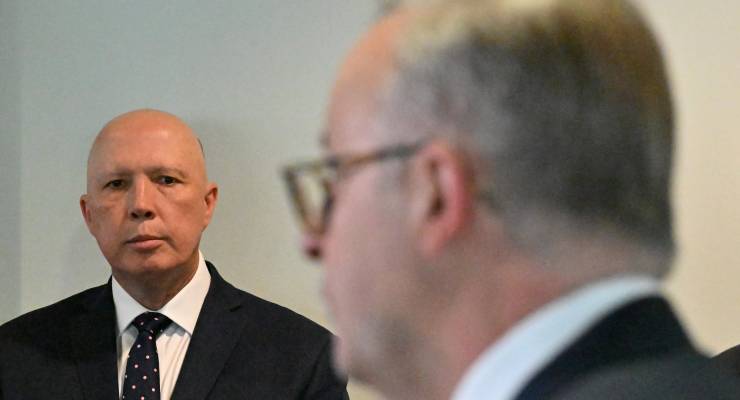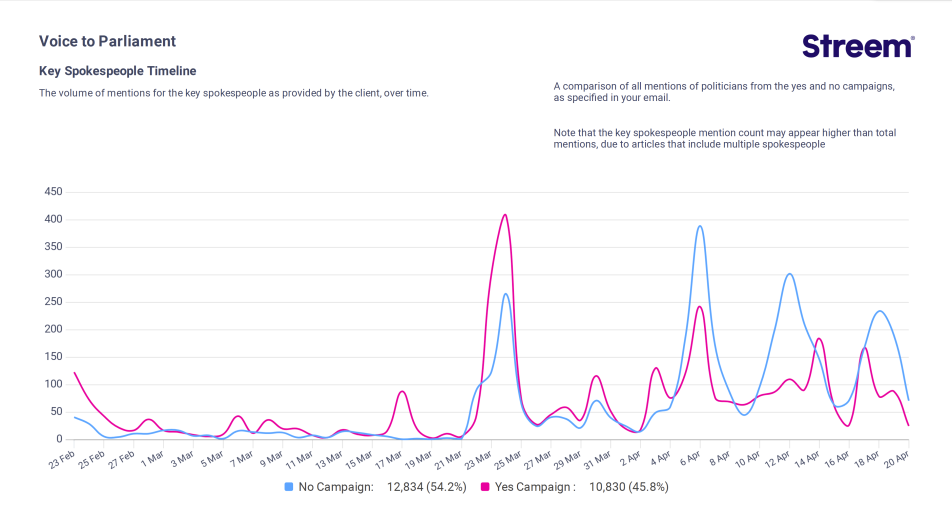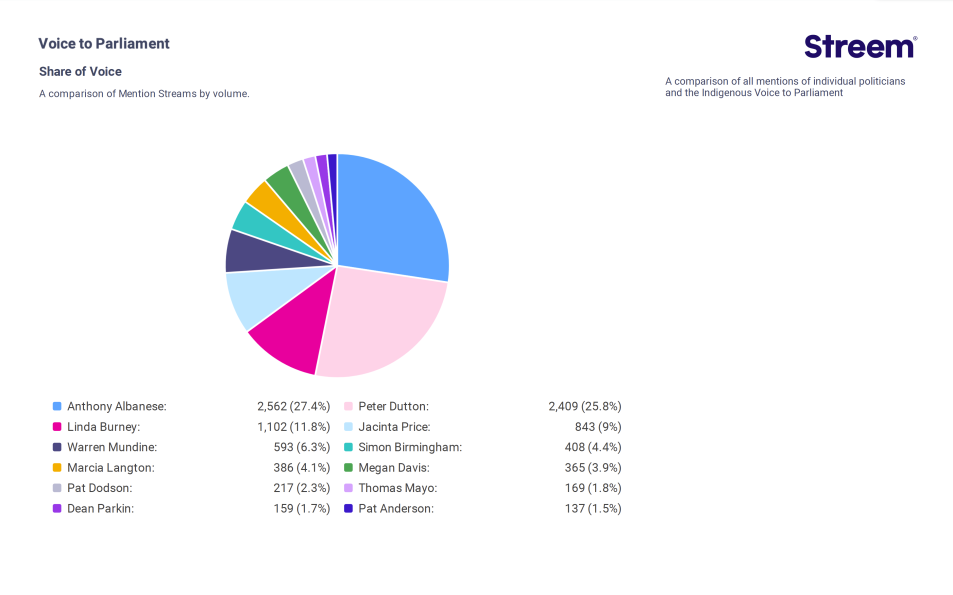
The No campaign is winning the battle for media coverage on the Voice to Parliament, new media monitoring data shows.
According to data from media monitoring firm Streem, key figures on the conservative No campaign led by Opposition Leader Peter Dutton secured 54.2% of Voice coverage in print, radio and television between February 23 and April 20, compared with the Yes campaign’s 45.8% share of 6309 mentions.

Media mentions were counted for key figures from both mainstream camps. On the Yes side, coverage was limited to Indigenous Minister Linda Burney, Indigenous Voice to Parliament working group members Professor Marcia Langton, Pat Anderson, Professor Megan Davis and Thomas Mayo, as well as Senator Patrick Dodson and From the Heart director Dean Parkin.
On the No side, mentions were limited to the opposition’s Indigenous Australians spokeswoman Jacinta Nampijinpa Price, Recognise a Better Way president Warren Mundine, and Opposition Leader in the Senate Simon Birmingham, and former opposition Indigenous spokesman Julian Leeser until he resigned from the shadow cabinet on April 11.
Prime Minister Anthony Albanese’s and Dutton’s mentions were also tracked, but with tighter parameters to distinguish between issues. For both men, mentions were clocked only if they fell within a 10-word proximity to the words “Indigenous Voice to Parliament”.
In that coverage, both dominated mentions with 2562 (27.4% of the total figure) and 2409 (25.08%) appearances, respectively. Albanese’s mentions spiked on March 23 when he revealed the referendum question, whereas Dutton’s appearances spiked on April 5 when he announced the Liberal Party’s decision to oppose the Voice.

The only other key figures with more than a 5% share are Burney with 1102 mentions (11.8%), Price with 843 (9%), and Mundine with 593 (6.3%).
Some of the campaign’s most authoritative voices secured the fewest media mentions. Anderson, the Uluru Dialogue co-chair, had just 1.5% of total media mentions, the lowest share over the campaign’s first two months, and Mayo accounted for 1.8%.
Davis made up a slightly higher share of mentions, at 3.9%, but Langton emerged as the most prominent non-government spokesperson for the Yes camp, securing 386 mentions, or 4.1% share of coverage.
However, the Yes campaign’s disadvantage in raw total mentions may be outweighed by its larger reach on its appearances, according to one measure. Streem provides a “potential audience reach”, which estimates how many people see media coverage based on what time and what format it’s published in.
By this measure, Albanese dominates all other figures with 40% of potential audience reach (estimated at 267.8 million impressions), followed by Dutton with 12.7% (84.9 million) and Burney with 10% (67.1 million).
The Yes side also has an early head start on social media so far, thanks to bigger established audiences on platforms such as Facebook and Instagram. But the No side is ramping up its spending to target specific voters with Facebook, Instagram and Google ads to make up for their organic disadvantage.
Radio stood out as the favoured media over the period, hosting 54.9% of total coverage, television had 25% of mentions, and the remaining 20.1% reached voters in print.
Have campaign ads and media reports changed your mind on a Voice to Parliament? Write to letters@crikey.com.au. Please include your full name to be considered for publication. We reserve the right to edit for length and clarity.









The No campaign is funded by the extremely wealthy who have made their money from exploiting natural resources of our country.
The same woman who has said people should be happy to work in her mines for $8 per day, whilst she pays very limited taxes, demonstrating her lack of social commitment is one of the leading lights of this campaign.
Anyone who throws their lot in with this group really should understand how close to the bottom of the barrel they are dredging.
The “No” camp should put Abbott in charge of campaigning…………………
…………that would pretty well guarantee the “Yes” vote gets up.
Interesting stats and TBF I’m surprised Yes got as much coverage as it did.
However the survey is of the MSM. This skews the findings as a large section of young voters ignore the MSM.
We can’t assume the young are 100% “Yes” but my guess is it’s a significant majority.
Coverage isn’t outcome so we’ll have to wait and see.
Agree, though more a bunch of disparate numbers trying to measure sentiments and intentions, while MSM attracts much of the fast growing 70+ years of electors.
One suspects the MSM and one influential media group of endeavouring to nobble the ‘yes’ vote by politicising it, i.e. platforming ahead of time Price, Thorpe & Mundine with media stunts, dog whistling of and cynicism towards the Voice referendum; like a form of astroturfing?
One hopes like the 1967 referendum giving Aboriginal Australians citizenship, was passed overwhelmingly, inc. by conservatives too, at 90%.
TBH I’ve given up thinking about it – I’ll just vote Yes – I hope my fears that the voice becomes a drag anchor on treaty and reconciliation are unfounded.
Decreasingly so. This is now the cohort which took to the streets in the hundreds of thousands in protest at the Viet Nam war, Franklin dam, uranium mining and so on. Haven’t seen any young people doing anything but posting incoherently on social media about inconsequential things such as the brand of their ‘sneakers’.
Who needs young people, even though they are dramatically outnumbered (ex. students etc. counted into population); baby boomers were so much better and less privileged with free university, being catered to by the LNP and media especially as they age, creating asset bubbles, tax rebates/cuts etc. on their way; like an anaconda digesting a cow for two more decades…..
They are not. The median Australian voter was born in 1981.
You understand, whatever the source, median age changes from electorate to electorate, and probably approaches the retirement age in many regions; accordingly SkyNews AD was desperate for free to air coverage.
Further, basic maths, the median age is increasing with an ageing permanent population (eligible to vote), hence more oldies and fewer younger voters and working age.
https://theconversation.com/more-grey-tsunami-than-youthquake-despite-record-youth-enrolments-australias-voter-base-is-ageing-115842
No chance. Neither the purpose nor moral case are anywhere near as clear.
Why, because then it was bipartisan, not presented as divisive right vs. centre and partisan issue by usual suspects in RW media and politics? Bit like immigrants and population, the same old Anglo or WASP nativist swamp?
In 1967 the purpose of that refferendum was to increase Australia’s population.
Count the Indigenous People’s as Citizens, and Australia had an instant growth in population, so ‘we” became a “bigger” country.
Everyone was a winner.
In today’s mindset, if someone wins, someone else has to lose, and nobody want’s to be the loser. It doesn’t work that way.
It is the same as winning tattslotto. Just because somebody wins a few million, I didn’t “lose”, I just didn’t win too.
The “no” campaign can’t seem to see this as a step along the road, and have decided that if The Voice gets the green light someone must have lost something.
It is a sad world in which we live.
Huge column-km tallies or aeons spent waffling on in the echo chambers of rightwing groupthink news channels isn’t the same as changing voter sentiment. I’ve barely heard any Yes arguments in MSM but the more I hear from the No side, the firmer I become in my Yes position.
I cannot be the only one.
Exactly, with No spend to date focused as “radio…hosting 54.9% of total coverage, television had 25% of mentions, and the remaining 20.1% reached voters in print” (if I’m reading this correctly) they’re only reaching a much older audience, who would probably be less likely to support the Voice anyway.
I’m curious if “TV” counts only as FTA or all media including ads on Foxtel, YouTube etc and any streaming platform with ads?
I have heard much more from No too. Because No has very a very limited genuine argument, it presents sensationalist and emotive false claims. The MSM is very attracted to such stuff.
The more coverage Price, Mundine and Dutton get the better as far as I’m concerned. The longer the campaign goes on, the more their lies will be exposed. So far they’re having no discernible influence on the polling #’s. Dutton and Mundine in particular are so toxic I can only see them as being a massive boost for the yes vote.
It will be interesting to see how this progresses especially with social media included. I saw Rebecca Huntley reported saying that people in her focus groups thought that the majority of First Nations people are anti a Voice. When she explained that surveys showed the vast majority in support, her participants said that this needed to be shared better with the general public.
I agree. I was speaking with a rural real estate agent yesterday (not domething I usually do), and he said he had spoken with an Aboriginal Seventh Day Adventist pastor who warned against making changes to the constitution (apparentlty its sacred) and anyway Aboriginal people do not want the Voice. I advised the real estate agent against taking constitutional advice from a priest, but not sure he was persuaded by a view that didn’t already suit him.
According to this link, Seven Day Adventists should not be giving advice on how to vote for any politician on any issue.
https://www.ministrymagazine.org/archive/1968/11/adventists-and-politics